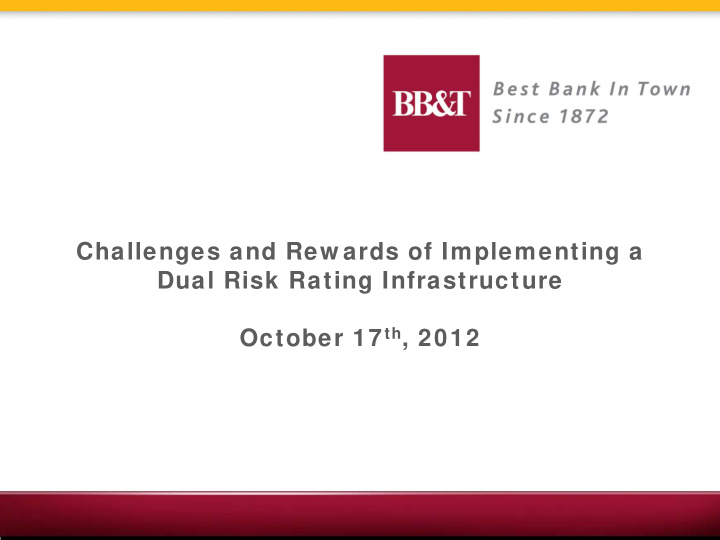



Challenges and Rew ards of Implementing a Dual Risk Rating Infrastructure October 17 th , 2012
BB& T Overview General Information 9 th Largest Bank in the U.S. based on Customer Deposits – – $178.5 Billion in Assets and Market Capitalization of $21.6 Billion – Employs nearly 33,000 with approximately 1,800 Financial Centers in 12 States and Washington, D. C. Organizational Structure – Community Bank Structure – 36 Regions each with a separate Regional President – Credit Approval Process – Analytical and Risk Grading Process Risk Grading – Current Methodology (Single Risk Grades) – C&I Risk Grading Process – Existing Template (MMAS) and Scorecard (General C&I) – CRE Risk Grading Process – Existing Template (MMAS) and Scorecard (General CRE and SFR) Existing Challenges and Opportunities – Data Integrity – Risk Grade Consistency CONFIDENTIAL
C& I Risk Grading Implementation Scorecard Overview – Moody’s RiskCalc and RiskCalc Large Firm • Version 3.1 • Credit Cycle Adjustment – Public Company Scorecard (Moody’s Credit Edge) – Excluded Industries • Specialized Industry Scorecards • Evaluating Impacts of RiskCalc 4.0 Template Overview – MMAS Template – Three (3) Custom Templates to Support Scorecard Deployment Above • Excel Prototypes Complete – Parallel Testing Underway RAFTA Deployment – Complete in 1 st Quarter 2013 • Emphasis on Data Integrity – Centralized Analytical Spreading Process – De-Centralized Completion of Risk Grading Process CONFIDENTIAL
CRE Risk Grading Implementation Scorecard Overview – CRE General Scorecards • Office, Retail, Industrial • Multifamily • Hotel • SFR – Monte Carlo Simulation Model (Larger Credit Exposures) Template Overview - CRE Analytical Workbook – Continuous Income Properties – Non-Continuous Income Properties Emphasis on Data Integrity – Centralized Analytical Spreading Process – De-Centralized Completion of Risk Grading Process CONFIDENTIAL
Loss Given Default Implementation Loss Given Default (LGD) Version 2.0 Completed October 2012 General Methodology – Universal Scorecard (CRE, C&I, Individual) – Weighted Average Collateral Coverage Calculation – Liquidation Values Based on Historical Loss Experience Individual Impact – Guarantors Impact Loss Given Default Grades – Substitution Permitted if Certain Minimum Parameters are Satisfied – Individual Risk Grading Methodology Still in Development Probability of Default Scale – 16 Grades Loss Given Default Scale – 6 Grades CONFIDENTIAL
Risk Grade Project - Timeline 2009 – Project Inception 2010 – Project Parameters Established – CRE Ratings Methodology – C&I Ratings Methodology Risk Grading Group Established in 4 th Quarter 2012 – 2011 – Initial Rollout Plan Established – June 2011 Pilot – CRE Monte Carlo Simulation 3 rd /4 th Quarter – Project Re-Conceptualized – 2012 – Rollout Plan 2.0 Established – June 2012 Pilot – Foundational Scorecards – 3 rd /4 th Quarter – Evaluating Initial Pilot Results, 3 rd Party Feedback 2013 – Complete Dual Grade Rollout – February 2013 Pilot – Specialized Scorecard 4 th Quarter 2013 – Bank-Wide Rollout – CONFIDENTIAL
Data Integrity – Methodology and System Solutions Current and Adequate Financial Information Data Capture – Analytical Spreading Process – Commercial Real Estate Analytical Process – Commercial and Industrial Analytical Process System Solutions – Client Management Solution – Analytical Spreading Solution – Loan Accounting System Solution Organizational Challenges – Build vs Buy Decision – System Integration CONFIDENTIAL
Organizational Dynamics Managing Change – Beliefs – Behaviors – Results – Community Bank – Collecting Client Financial Information – Commercial Credit Administration – Existing Credit Culture Project Leadership – Executive Sponsor – Enterprise Risk Manager – Project Leader – Credit Policy and Governance – Project Manager – Enterprise Risk Management – Line of Business – Chief Commercial Credit Officer – Line of Business – Senior Commercial Real Estate Manager – Line of Business – RGG Manager – Line of Business – ERM Risk Analytics Decision-Making Process – Commercial Risk Grade Governance Committee – Ad Hoc Meetings with Executive Management CONFIDENTIAL
Training Strategy and Implementation Training Strategy - Foundational Progression – Assess Organizational Competency – Current and Adequate Financial Information/Analytical Spreading – Identify and Address Deficiencies – Develop Long Term Training Strategy • Utilize Online Channel – Captivate (40-50 Interactive Modules) • In-Person Training – Two (2) Lab Sessions (3,000+ Individuals) • Post-Training Assessment – Position-Specific Certification Program(s) • Account Officers • Portfolio Managers • Credit Officers Training Materials – Universal Access and Version Management – SharePoint Development – Position-Specific Playbooks CONFIDENTIAL
Summary Risk Grade Project Structure and Leadership Organizational Assessment – Foundational Execution – End to End Data Integrity – System Assessment – End to End Data Integrity Risk Grade Methodology – Determine Primary Objectives (Basel) – Determine Rating System Priorities • Point in Time vs Through the Cycle • Forward Looking Components • Portfolio Strategy and Specialized Scorecards – These Decisions Should not be Revisited Develop, Design, and Implement Data Capture Components Develop, Design, and Implement Risk Rating Components Continual Optimization (DMAIC) CONFIDENTIAL
Recommend
More recommend